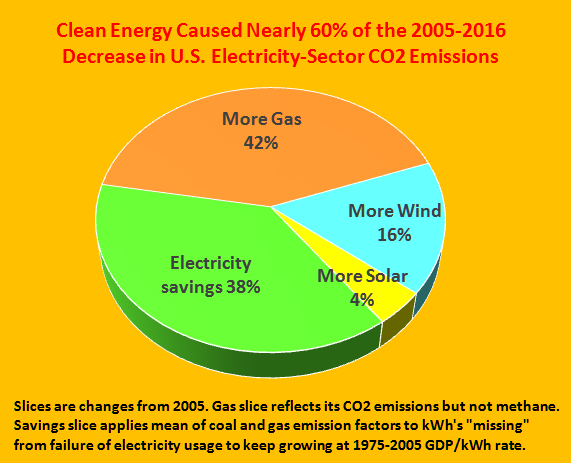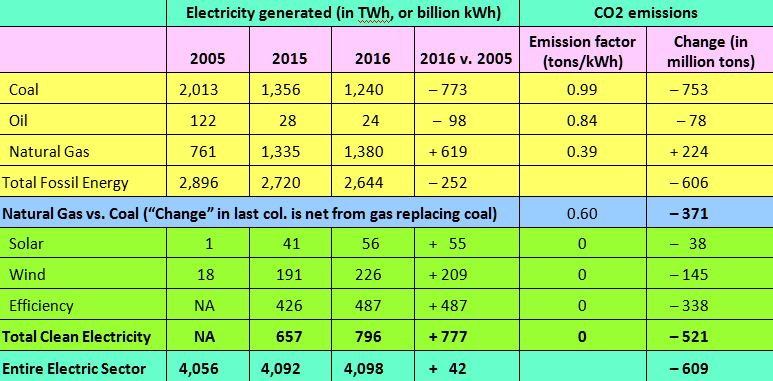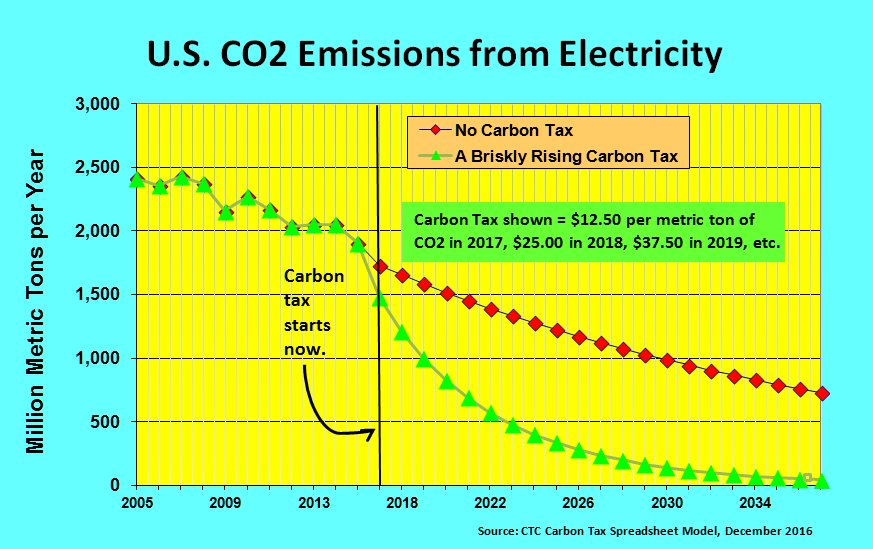We’ve just updated this post, replacing estimated 2016 electricity data with actual. The pdf in the link in the first paragraph has been updated as well. — C.K., March 22, 2017
Today we released a new CTC paper (pdf) reporting and explaining what we call the good news of the U.S. electric power sector’s rapid decarbonization over the past decade.
The paper quantifies the power sector’s sizeable reductions in carbon emissions since 2005 and clarifies what accounts for it. We show that while substitution of fracked gas for dirtier coal contributed significantly to reducing emissions, a greater role was played by clean electricity: an upsurge in electricity production from renewables (wind turbines and solar photovoltaic cells), and electricity savings that caused electricity usage to flatten even as economic output increased.

Clean Energy = Electricity Savings + Solar + Wind
By the end of 2016, the U.S. power sector had reduced its emissions of carbon dioxide by 25 percent since 2005, thus achieving nearly four-fifths of the 2030 carbon-reduction goal set by the Obama Clean Power Plan. While this suggests the CPP goals were too modest, this is genuine progress, even if confined to electricity (omitting vehicles, refineries, industrial processing, etc.).
The good news gets even better: we estimate that 58 percent of the electricity sector’s CO2 reduction in 2016 vis-a-vis 2005 was due to clean electricity, and just 42 percent due to replacing coal with natural gas. This finding belies the prevailing narrative crediting fracked gas for reducing coal burning and lowering carbon emissions.
The electricity sector’s reduction in carbon emissions is good news not only because of its magnitude but because it effectively “banks” emission reductions against a slowing of progress looming under the Trump administration. The leading role played by clean electricity is good news because it comes without the climate-damaging methane emissions associated with natural gas extraction and transportation, and because it signifies the emergence of a new energy economy built on inherently clean energy production and usage technologies that can scale rapidly, economically and gracefully.
While this trend is heartening, far more is needed for the United States to meet its economy-wide carbon-reduction pledge under the Paris climate agreement, especially in light of the rise in emissions in the transportation sector spurred by cheap petroleum fuels, which we’ve been reporting for two years. That surge underscores the need for robust carbon taxes to stimulate big emission reductions.
Key to the emission reductions is the the virtual leveling off of U.S. electricity usage and generation since 2005. Total U.S. electricity generation in 2016 was just 1 percent greater than the 2005 baseline. In fact, electricity generation and use for the entire post-2005 period has been remarkably constant, i.e., flat. This leveling of electricity generation over the past decade is a striking exception to the history of electric power in the United States, when electricity production and use doubled every decade from 1900 to 1970 and more than doubled again from 1970 to 2000.
Of course, the post-2005 period includes the Great Recession, whose epicenter was 2009 and from which the recovery has been sluggish. It’s tempting to attribute the post-2005 flattening of U.S. electricity use to anemic economic growth. But that would be not only simplistic but mistaken. GDP grew by 17 percent during 2005-2016. As we show in the report, if the 1975-2005 relationship between growth in GDP and growth in electricity generation had continued after 2005, then electric output in 2016 would have exceeded 2005 output by 13 percent, rather than the mere 1 percent increase for 2016 over 2005.
What we’ve done in The Good News is quantify that difference, in both saved electricity and avoided carbon emissions. In terms of climate impact, the electricity savings in 2016 was roughly as consequential as the vaunted pushing out of coal-fired electricity by natural gas. Indeed, if not for the savings, much of the boom in fracked gas would have been in addition to continued coal consumption.

Our “Good News” report is data-intensive.
Important note for table: Sector-wide CO2 reduction in last cell (609 million metric tons) is smaller than sum of CO2 reductions credited to gas (371 million) and clean electricity (521 million) because latter figure credits efficiency for averting CO2 increases that would have resulted if electricity use had grown parallel with economic activity.
Why has electricity usage become decoupled from overall economic activity? Many factors have been involved, and they tend to be both overlapping and hard to quantify. They include a shift by young adults to urban living and delayed family formation; new energy-reducing technologies that are being adopted by a widening base of engaged customers (who in turn feed demand for these devices and systems); ratepayer-funded energy-efficiency programs along with governmental codes and standards for buildings, appliances and other end-use equipment, all increasingly backed by a support structure of software, best practices, and monitoring and evaluation; structural changes in the economy including the shift from energy-intensive heavy manufacturing to service industries; emergence of a robust business sector that finds, finances and delivers money-saving efficiency improvements in commercial buildings and multifamily housing; and widening penetration of digital technologies in everything from energy management to product design, most notably in LED’s but also in thermostats and appliances. (See the report for fuller discussion.)

“Briskly Rising Tax” uses rate proposed by former U.S. Rep. Jim McDermott. Year 2016 isn’t shown because of graphic quirk in CTC model.
The progress to date in reducing electricity-sector emissions has been accomplished without a price on carbon pollution. Notwithstanding the election result, a carbon tax remains the most powerful policy tool for rapidly driving down emissions in the power sector and, especially, the rest of the economy. The chart at left illustrates just how fast a robust and briskly rising carbon tax could drive down electricity-sector emissions. Such a tax would accelerate the ongoing decarbonization of electricity supply by increasing the returns from substituting zero-carbon electricity sources for fossil fuel generation. The tax would further reduce emissions by dampening electricity usage through the charge it adds to electric rates; however, that effect would be relatively modest and transitory since the carbon content of each kWh would shrink over time, diminishing and ultimately zeroing out the tax base.
We’ve estimated that the carbon tax levels mandated under the McDermott bill would have reduced economy-wide CO2 emissions from fossil fuel combustion — not just from electricity but from motor vehicles, air travel, industry, etc. — by one-third within a decade. While the political hurdles are higher under a Trump administration, the need for a robust carbon tax remains at least as strong as ever.
Addendum, Jan. 11, 2017: Today, the Sallan Foundation published another take by us on this topic, Almost Unnoticed, Flat Electricity Demand Is Crushing U.S. Carbon Emissions. It has two new graphs and a bit more detail than this post outlining how and why U.S. electricity use has flatlined since 2005.

Bill hayes says
Couldn’t agree more. In the absence of federal policy, maybe states can impose a consistent tax at least on transportation and power
Homer Williams says
I fully support the concept of a carbon tax and strong rules on fracking. However, as a resident of NYC, natural gas is the only economic alternative at this time to the use of fuel oil for building heat and hot water. Moreover, in addition to reducing CO2 output, the use of natural gas drastically reduces PM 2.5, which studies have shown to be a major health issue in NYC. By switching to natural gas, our building is reducing its CO2 output by about 60 tons per year. By vilifying fracking, as opposed to advocating strict regulation, you are departing from you stated mission of reducing CO2 and are helping to discourage the use of natural gas in NYC.
Moreover, anyone can see that the major gains to “clean energy” in your report are due to energy savings, not to wind or solar. Although this is in your tables, you fail to give it the proper emphasis in the text of your report, and your claim that energy savings is part of “clean electricity” is clearly questionable. Electricity saved is not produced, although it certainly reduces CO2 output.
I firmly believe that a carbon tax is a potentially useful tool in reducing CO2. However, oversimplified and misleading reporting are not going to help pass legislation in what is becoming an even more hostile political environment.
Charles Komanoff says
Homer, we’re glad you commented and that you support carbon taxes.
You’re correct of course that the major part of the “clean energy” or “clean electricity” gains in our report are due to electricity savings. It’s surprising that you don’t believe those savings, most of which are attributable to energy efficiency, deserve to be classified as clean energy. That false distinction was called out for criticism in the seventies and is, by now, anachronistic. After all, why should an electric clothes dryer powered by solar PV be considered clean whereas drying clothes on a clothesline (also “solar” though not PV) is not? Or, for that matter (and more heretically), wearing clothes more times between washings?
I’m surprised you think my report or CTC generally vilify fracking. We generally strive for technology-neutrality, so long as the social and environmental costs of each are reflected in their prices. What have we said specifically that leads you to think we vilify fracking?
It’s incontrovertible that replacement of fuel oil by gas in generating electricity and steam and in on-site building heat and hot water has been an important contributor to NYC’s improved air quality. But so too was the earlier replacement of high-sulfur oil by low- and then ultra-low-sulfur oil. In any event, improving buildings’ energy efficiency (through enhanced HVAC, tighter building envelopes, etc.) obviously works in conjunction with cleaner fuels to reduce emissions.
Jessica says
I am an electrician, in Texas.
We need a transition away from burning precious renewable resources. We all learn this in school, but greed is a mighty help in forgetting the real needs.
Franking is not the answer. Since Texas has started franking, we have seen a steady earthquake rise in the Dfw area and Oklahoma. They have put the sludge left over from draining each and every spot they find back in the space where the natural gas resides. This causes expansion where it shouldn’t. Fracking will cause Yellow stone to blow. Yes, our county sits atop a giant, for lack of a better term, pimple on the planets surface. And we all know if you put too much pressure on a pimple it pops on it’s own. This country would not survive the blast.
Dams are not a full means of sustainability either. They cut off natural flow ways for sediment to pass the way it naturally has since this planet exploded into being. It’s already been proven at the hover dam. If you travel down to the very end of the river past the dam there are plain signs of this effect. Other tribes in smaller countries now have to buy water bottles because over the past 2 decades the damming has caused contamination.
We have known about our poor usages of resources since the 30s. In the 50s there was a push for solar, but that got squashed by the government, just as our needs as a whole are about with this one.
It doesn’t take nearly as much to create electricity as people think.
If we could better educate the populous with FACTUAL information and not paid for information, we may have a chance.
But, if our species is bent on overpopulation then we have to make a difference now.
Tesla tried in the Victorian error to get better forms electricity. Now, hopefully Elon Musk and his company can kick start the growth.
Jessica says
FRACKING* ( see even spell checked doesn’t like it.)